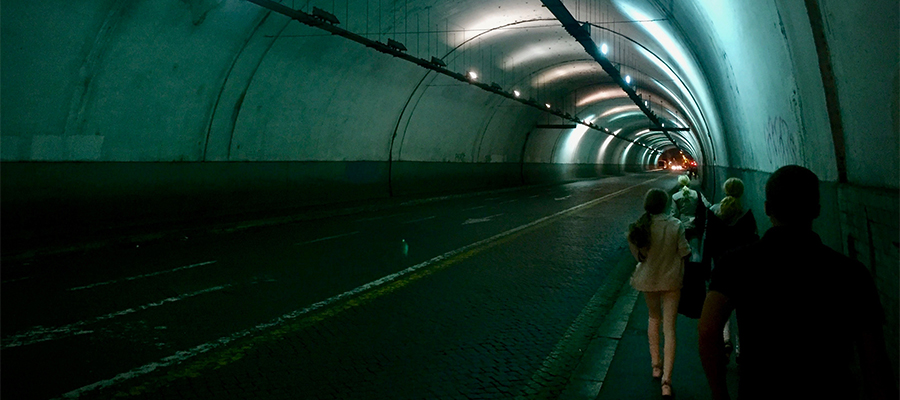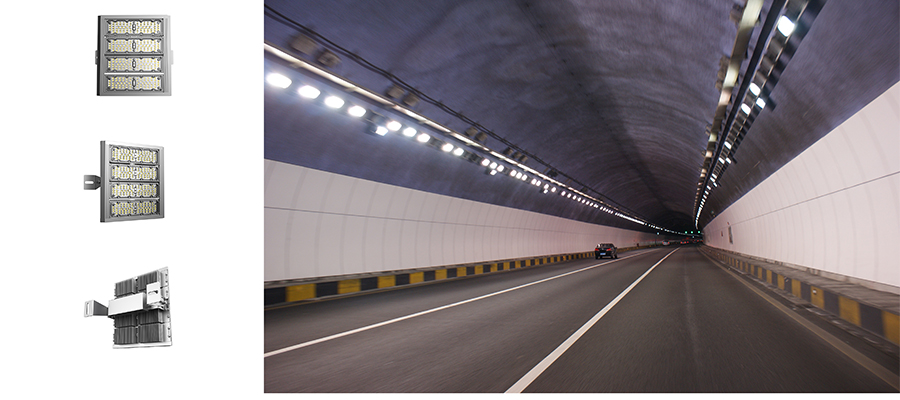3 Aspects You Need to Consider of Tunnel Lighting Design
2022-03-04
VIEW "2876
Tunnels are the main structure of mountain highways, and their proportion is increasing in road construction. Due to the peculiarities of the road and traffic environment, the tunnel has also become a traffic accident-prone section. Therefore, whether it is day or night, no matter what the weather, we should provide the driver with a comfortable and safe driving environment, so that the driver can clearly know road conditions and keep safe drive.

Part 1 Tunnel lighting function requirements
- Improve traffic safety and reduce the rate of traffic accidents
- Increase traffic guidance and road utilization efficiency
- Reduce crime rates
- Improve environmental comfort
- Provides visual adjustment when switching between light and dark environments
Ordinary tunnels are divided into five zones: access zone, entrance zone, transition zone, inside zone, and exit zone.
1. The access zone
The zone refers to a section of road outside the tunnel entrance, where the driver must be able to see clearly the objects in the tunnel. This is also the stage of the driver's visual adjustment, which determines the brightness requirements of the tunnel entrance and tunnel entrance zone. At day, due to the strong contrast between the high brightness of the environment outside the entrance and the low brightness in the tunnel, and also due to the temporary visual impact of the driver’s eyes on the bright environment, a black hole will be seen at the entrance of tunnel. When drivers reach this zone, people cannot see any details in the tunnel. This is called "adaptation hysteresis", which is the result of the inability of the human eye to adapt quickly.
2. The entrance zone
The entrance zone is the first zone of the four zones of the tunnel. Drivers driving near this area must be able to see the road surface at the entrance before entering the tunnel to eliminate the "black hole" phenomenon.
The length of the entrance zone depends on the maximum speed of the tunnel design, at least equal to the safe braking distance at the maximum speed. This is because the road at the far end of this zone should be used as a background for drivers who are about to enter the tunnel beyond the safe braking distance to see the obstacles.
3. The transition zone
After a relatively high threshold level of lighting, the lighting in the tunnel can be gradually reduced to a very low level, it's the transition zone.
The length of the transition zone depends on the design maximum speed and the difference between the lighting level at the end of the entrance zone and the inside zone. The transition zone may be divided into 1~3 sections according to different lighting levels.
4. The inside zone
The inside zone is the area in the tunnel far away from the external natural light, and the driver's vision is only affected by the lighting in the tunnel. The characteristic of the inside zone is that the entire section has a uniform lighting level. Because there is no need to change, this segment only needs to provide a suitable brightness level, and the specific value is determined by the traffic flow and the speed of the vehicle. However, this zone is different from general roads and is more dangerous than driving on a general open road. Exhaust gas emitted by cars in the tunnel cannot be dissipated in time, causing white smoke ahead, which is diffused into a light curtain by lights, reducing visibility. Therefore, in this zone, the lighting level is required to be higher than the general road.
5. The exit zone
In this zone, the visual adaptation is the transition from low brightness to high brightness. When approaching the tunnel exit, natural light comes in. The external brightness is extremely high, which is likely to cause strong glare effects. On the contrary, the tunnel exit becomes a black hole at night. In this way, it is not easy to see the route and obstacles. These are the issues that must be considered for tunnel lighting.
Part 2 Why lights in entrance and exit of the tunnels are denser?
Before talk about that, we first to know what "dark adaptation" and "light adaptation" are. From a bright place to a dark place suddenly, the eyes will see nothing in a short time, and it will take a period of time (a few seconds to a few minutes) to slowly adapt. This phenomenon is called "dark adaptation" of the eyes. On the contrary, it is "clear adaptation."
If the difference in light intensity between inside and outside the tunnel is too large, human eyes will have short-term visual impairment, which is very dangerous for the driver. This is why the lights at the entrance and exit of the tunnel are denser.
During the day, the light inside the tunnel is dark. The dense light at the entrance and exit allows the eyes to still feel that the outside is bright, so that the brightness of the tunnel will not be much different from the outside. Then the density of tunnel lights is getting lower and lower until normal. The eyes gradually adjusted to the darker light. In the same way, when exiting the tunnel, the outside of the tunnel is brighter, and the inside is dark. From exiting the tunnel, the light is gradually strengthened, so that the human eyes can gradually accept the brightness of the outside, and the driver will not be too bright all at once, causing visual obstacles to the driver.

Part 3 EXC Smart Tunnel Lighting System
EXC smart tunnel lighting system, combined with tunnel lighting control equipment, is able to achieve functions of centralized control, real-time data monitoring, abnormal intelligent analysis and fault alarm for all tunnels within the scope of the project, and prevents light failure, aging, loss and various emergencies of the spot. What's more, this system can also implement tunnel light asset management, report management, and big data analysis applications to meet user needs of upgrade.
According to the special conditions of the tunnel, the system can collect information such as the brightness value and traffic flow in the tunnel, adjust the brightness value of the tunnel by adjusting the output power of the LED lights, and adopt the method of segmented lighting control to control the lamps in each zone of the tunnel. Carry out independent group control to achieve maximum energy saving under the premise of ensuring driving safety.
In addition, the tunnel lights installed with this system can adjust the brightness according to the actual changes in the driving, so as to provide the driver with the best view and ensure driving safety.

